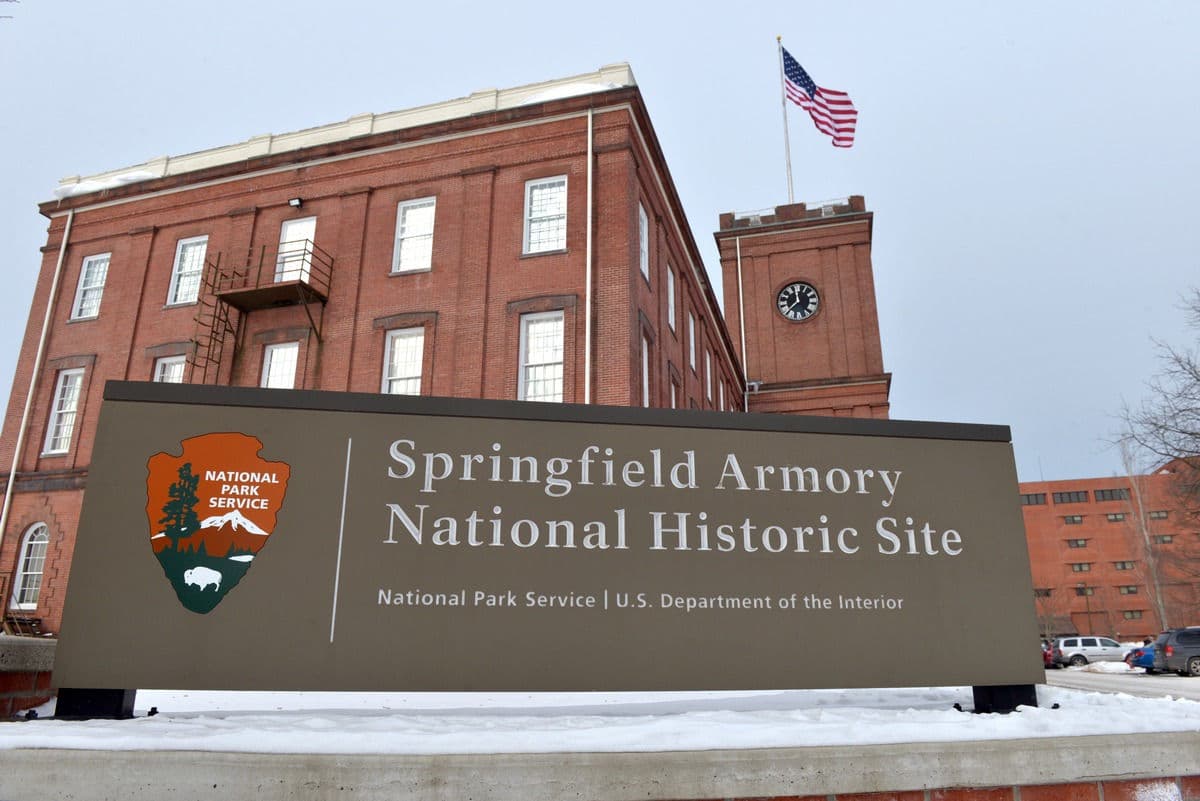Key Takeaways:
- Springfield wasn’t just a gun factory—it reshaped how America made things: From interchangeable parts to early assembly-line techniques, the Springfield Armory didn’t just arm soldiers—it helped invent the blueprint for modern manufacturing. Its influence reached far beyond the battlefield and into the DNA of American industry.
- The Armory’s firearms were more than tools—they were symbols of American grit: Whether it was the Model 1795 musket, the M1903 bolt-action, or the legendary M1 Garand, Springfield’s weapons became part of America’s identity in times of war. These rifles didn’t just fire rounds—they helped shape history.
- Even after closing, the Armory’s legacy never missed a beat: Though the original government facility shut down in 1968, its story didn’t end there. Its techniques, its impact, and even its name live on through museums, modern manufacturers, and the cultural memory of a nation that still reveres its craftsmanship.
Humble Beginnings With a Revolutionary Purpose
Let’s rewind to 1777. The American colonies were deep in the throes of revolution, and the need for reliable weaponry wasn’t just a priority—it was a matter of survival. Enter the Springfield Armory, founded in Springfield, Massachusetts, on orders from George Washington himself. Why Springfield? Simply put, it sat near the Connecticut River, offering ideal transportation and natural defenses. But more than that, it was far enough inland to be safe from coastal attacks—a practical yet strategic choice.
Back then, the Armory wasn’t just another factory. It was a hive of activity where skilled craftsmen turned raw materials into tools of war, mostly muskets and other small arms, for the Continental Army. These artisans weren’t just making guns; they were keeping the fight for independence alive, one weapon at a time.
After the dust of the revolution settled, the Armory didn’t fade into the background. In 1794, the federal government officially designated it as a National Armory. That recognition wasn’t just ceremonial—it marked the beginning of a new era in American manufacturing. The Springfield Armory became a central figure in a quiet but powerful revolution: the move toward standardized, interchangeable parts. What we now take for granted in modern manufacturing started right here.
By the early 1800s, the Armory had become more than a factory. It was a laboratory for ideas—a place where innovation wasn’t just encouraged; it was expected.
19th-Century Powerhouse: Guns, Gears, and Getting It Right
The 1800s were a period of rapid change, particularly in the realm of warfare and weaponry. And Springfield was right in the middle of it all.
One of its first big wins? The Springfield Model 1795 Musket. It was the first musket made in the United States, and it quickly became the gold standard. Think of it as the smartphone of its day—every soldier wanted one. Then came the Civil War, and with it, an enormous demand for better, faster, and more reliable firearms.
The Armory responded with the Springfield Model 1861 rifled musket. If you’re imagining long lines of Union soldiers with bayonets affixed, this is probably the weapon they were holding. Its accuracy and reliability made it one of the most widely used guns of the war.
Here’s the kicker: During this time, the Armory began moving away from purely hand-built guns and leaned into mechanized production. That shift wasn’t just good for volume—it helped ensure consistency, reliability, and speed. The birth of the assembly-line mindset didn’t come from Detroit; it was sparked right here in Springfield.
As the century progressed, innovation continued to emerge. The Springfield Model 1873 “Trapdoor” rifle introduced a breech-loading mechanism that let soldiers reload faster—no more awkward fumbling with muzzle-loaders during a firefight. It became the U.S. Army’s standard-issue rifle and marked another leap forward in firearm design.
But let’s not forget the broader impact. The Armory wasn’t just building better guns; it was reshaping manufacturing. The idea that parts could be made to such precise standards that they’d be interchangeable? That was game-changing. It laid the groundwork for mass production across industries—from cars to typewriters and beyond.
20th Century: The Springfield Arsenal Hits Its Stride
If the 19th century built the foundation, the 20th century turned the Armory into a powerhouse. It faced the ultimate test with the outbreak of World War I. The Springfield M1903 rifle—developed in the early 1900s—was at the forefront. This wasn’t just a gun; it was a mark of engineering excellence. Accurate, dependable, and rugged, it helped define America’s military might during WWI.
Between the wars, Springfield didn’t sit idle. In the 1930s, a man named John C. Garand introduced a rifle that would revolutionize the field—the M1 Garand. A semi-automatic rifle at a time when most armies were still using bolt-action rifles? That was revolutionary. During World War II, the M1 gave American troops a clear advantage in firepower. General George Patton even called it “the greatest battle implement ever devised.”
By WWII, the Armory had reached a fever pitch of productivity. But it wasn’t just churning out weapons—it became a symbol of American resolve and manufacturing grit. The tools of war rolling out of Springfield helped turn the tide in Europe and the Pacific.
Even after the war, Springfield continued to push boundaries. But times were changing. Private manufacturers began stepping in to fulfill military contracts, gradually shifting the landscape. Despite its historic role and continued innovation, the Springfield Armory faced an uncertain future.
Then came 1968. After nearly two centuries of service, the federal government closed the Armory’s doors. It marked the end of an era—but not the end of the story.
More Than Metal: A Legacy That Outlived Its Tools
Closing the Armory didn’t erase its legacy, far from it. Its closure only highlighted how deeply it had become woven into the fabric of American history and identity.
Let’s start with the guns. The M1 Garand, the Model 1903, the Trapdoor Springfield—these weren’t just weapons. They were symbols of American perseverance and battlefield brilliance. Veterans still speak of them with reverence. Collectors chase them. Historians write entire books about them. They weren’t just tools; they were milestones.
The Armory’s impact also rippled through the world of manufacturing. Its early adoption of interchangeable parts and semi-mechanized production was a spark that helped ignite the Industrial Revolution in America. From rifles to refrigerators, the methods born in Springfield shaped how things were made.
And then there’s the cultural side. In 1978, a decade after it closed, the site became a National Historic Site. Today, the Springfield Armory serves as a museum and educational center. It’s not just a place to look at old guns—it’s where people come to understand a pivotal chapter of American history. School groups visit. Researchers dig through archives. Veterans return to see the machines that once armed them for war.
Oh, and Hollywood noticed too. Springfield rifles and Garands have made their way into countless movies, TV shows, and video games. The Armory’s creations became icons of both American strength and storytelling.
Carrying the Torch: The Name Lives On
Now here’s where things get interesting. Although the original, government-run Springfield Armory shut down in ’68, the name didn’t vanish. In 1974, a private company—Springfield Armory, Inc.—picked up the torch.
This new company had no official ties to the historic site, but it took the name as a tribute to that legacy. And it has made a name for itself, too. With modern versions of classics like the M1911 pistol and the M1A rifle (a civilian twist on the M14), Springfield Armory, Inc. carries forward the tradition of quality and performance.
But beyond branding, the original Armory’s influence is still felt in every modern firearm factory. The techniques it pioneered are embedded in the DNA of modern weapons manufacturing. Interchangeable parts. Precision machining. Scaled production. It’s all there.
Military historians still teach about Springfield. Engineers still reference its contributions. And firearm enthusiasts, from casual shooters to seasoned collectors, recognize the Springfield stamp as a sign of something exceptional.
In many ways, the closing of the Armory marked the beginning of a larger national conversation about preserving industrial and military heritage. What should we remember? What’s worth saving? For Springfield, the answer was clear—everything.
The Final Shot
So, what’s the legacy of the Springfield Armory?
It’s not just in the weapons it produced or the wars it helped win. It’s in the shift it inspired—from artisanal craftsmanship to modern manufacturing. It’s in the soldiers who relied on its rifles, the engineers who built upon its methods, and the everyday Americans who take pride in its history.
More than a building or a brand, the Springfield Armory became a symbol of innovation, strength, and American ingenuity that refuses to quit.
And honestly? That’s a story worth telling.
Frequently Asked Questions
It was founded in 1777 to supply the Continental Army with weapons during the American Revolutionary War. George Washington himself chose the site, valuing its defensible position and access to the Connecticut River. It quickly became a hub not just for gun-making, but for American independence.
Because it helped kick off the entire idea of interchangeable parts—something we now take for granted. Springfield’s early focus on standardization paved the way for the mass production techniques that would later revolutionize industries from automobiles to appliances.
Three come to mind instantly: the Model 1795 musket (the first U.S.-made musket), the M1903 bolt-action rifle used in World War I, and the legendary M1 Garand from World War II. That last one? General Patton called it “the greatest battle implement ever devised.”
Absolutely. The Armory played a crucial role in equipping Union forces. It produced the Springfield Model 1861 rifled musket, which became one of the most widely used weapons during the war, renowned for both its accuracy and reliability.
Times changed. By the 1960s, the military was leaning more on private manufacturers for its weapons. That shift in strategy made a government-run facility like Springfield less necessary. In 1968, it was officially closed—but not forgotten.












